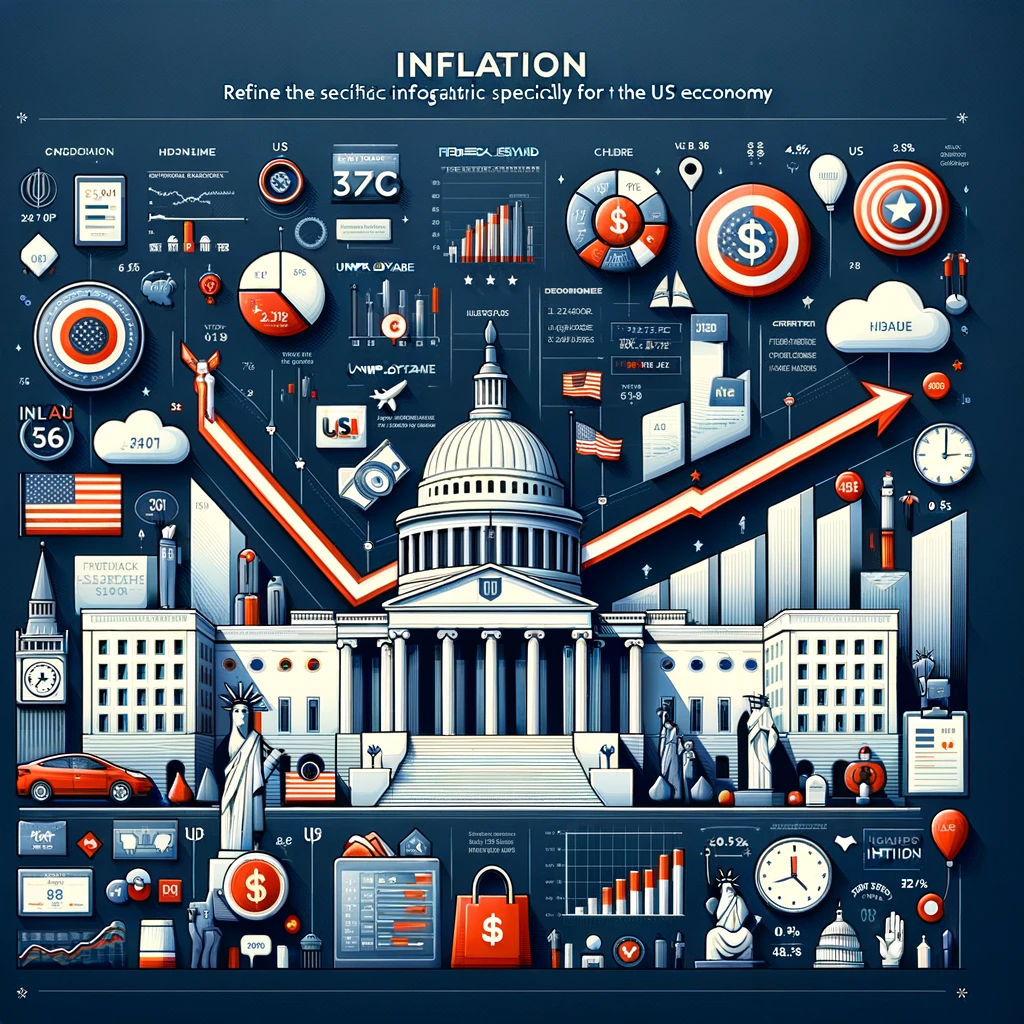Inflation Trends and Expectations in the US: A Roller-coaster Ride
2024-02-05

U.S. Inflation Fluctuates Throughout 2023, Signaling Potential Stabilization at Elevated Levels
The latest monthly data on the Consumer Price Index (CPI) for All Urban Consumers All Items in U.S. City Average reveals a notable trajectory in U.S. inflation. January 2023 recorded a year-over-year change of 6.6%, marking a significant increase from the previous months. However, a shift is observed in subsequent months, with the figure tapering down to 4.9% in March and holding steady through April. May saw a further decline to 4.1%, followed by a more drastic drop to 2.9% in June. This downward trend was short-lived, as July and August witnessed a slight increase to 3.1% and 3.6%, respectively. September and October held steady at 3.6% and 3.2%. Notably, December 2023 saw a modest uptick to 3.6%. Comparing these figures to historical data, it is evident that 2023 experienced a peak in inflation, with a substantial surge from 1.2% in 2020 to 8.0% in 2022. The subsequent dip in 2023 to 4.1% indicates a potential stabilization, albeit at an elevated level compared to earlier years. These changes may reflect a combination of global supply chain disruptions, increased demand, and adjustments in monetary policy. Despite the recent moderation, the sustained level of inflation warrants continued monitoring for its impact on consumer purchasing power and overall economic stability. This analysis underscores the need for policymakers and businesses to closely assess these inflation dynamics in shaping their strategies and decisions in the coming months.
Title: Roller-coaster Ride of the Sticky Price CPI Reveals Deflationary Trend in U.S.
The Sticky Price Consumer Price Index, which tracks goods and services with infrequently changing prices, reveals intriguing insights into U.S. inflation. The year-over-year change in this index has shown a remarkable roller-coaster ride over the past year. Starting in January 2023 at 64.6%, the index experienced a sharp decline to 20.6% by May 2023 and plunging into negative territory in the following months, hitting -30.6% by December 2023. This dramatic shift is quite a departure from previous trends, where the average year-over-year change in the index was 8.4% for 2023, significantly deviating from the prior year's rollercoaster ride. Looking back, the contrast of the swelling index in 2022, which reached an exceptional 130.2%, further underlines the significance of the recent downturn. These stark shifts in the Sticky Price CPI suggest a period of deflation and economic contraction in the U.S., which may signify a broader trend of declining prices and demand across key sectors. This deflationary trend could have profound effects on consumer spending, business investment, and overall economic growth if sustained. Such patterns warrant close monitoring and analysis to anticipate the potential impacts on the broader economy and monetary policy.
University of Michigan's Monthly Inflation Expectation Fluctuations in 2023
The latest monthly data on the University of Michigan's Inflation Expectation (Median expected price change next 12 months, Surveys of Consumers) shows some interesting trends. In Jan 2023, the inflation expectation stood at 3.9%, which then increased to 4.1% in Feb, and subsequently decreased to 3.6% in Mar. However, in Apr, a significant spike was observed with the inflation expectation reaching 4.6%. The following month, in May, it decreased slightly to 4.2%, and in Jun it dropped further to 3.3%. This trend continued with the inflation expectation being at 3.4% in Jul, 3.5% in Aug, and 3.2% in Sep. However, a noteworthy deviation from this trend occurred in Oct and Nov, where the inflation expectation surged to 4.2% and 4.5% respectively, marking a substantial increase. The year ended with a decrease in inflation expectation to 3.1% in Dec. These fluctuations suggest a level of uncertainty and potential volatility in consumers' expectations regarding future price changes. The data indicates that consumers may be reacting to various economic factors such as energy prices, supply chain disruptions, and labor market conditions, all of which can have significant implications for future U.S. inflation rates.
February 2024 Breakeven Inflation Rates: 5-Year at 2.35%, 10-Year at 2.3%, 30-Year at 2.24%
The latest monthly data on the Breakeven Inflation Rate, as reported by the Federal Reserve Bank of St. Louis, shows the following figures for February 2024: - 5-Year: 2.35% - 10-Year: 2.3% - 30-Year: 2.24% These numbers represent the market's expectation of annual inflation over the respective time horizons and are derived from the yield differences between Treasury Constant Maturity Securities and Treasury Inflation-Indexed Constant Maturity Securities. The breakeven inflation rates are crucial for investors, policymakers, and analysts as they provide insights into market expectations for inflation, which in turn can influence investment decisions, monetary policy, and economic forecasts. It's important to monitor these figures closely as they can signify changing inflation sentiment and impact various sectors of the economy, from fixed-income investments to consumer spending patterns.
Federal Reserve Bank of Cleveland Reports Expected Inflation Rates for Various Time Horizons in January 2024
The latest monthly data from the Federal Reserve Bank of Cleveland provides insight into the expected inflation rates over the next 1, 2, 5, and 10 years. As of January 2024, the expected inflation rates are as follows: 2.43% for the 1-Year period, 2.33% for the 2-Year period, 2.18% for the 5-Year period, and 2.16% for the 10-Year period. These figures are critical for understanding how inflation expectations may impact various financial instruments, investment strategies, and economic policies. It's important to note that these figures are not actual inflation rates, but rather market-based expectations of future inflation. It's also worth considering that these expectations are influenced by a wide range of factors, including economic outlook, monetary policy, and market sentiment. Therefore, while these figures are valuable indicators, they should be interpreted alongside other economic data for a comprehensive understanding of the inflation landscape.
